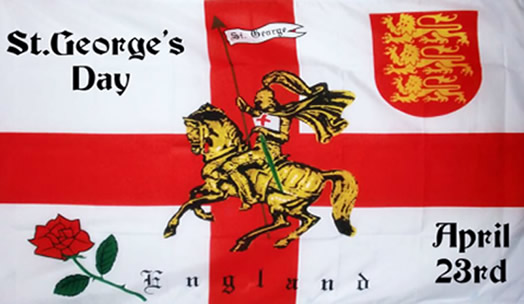News Archive
23/04/20"Happy St. George's Day everyone"

Like many early saints, the exact details of the life of St. George remain a mystery.
The most famous story is St. George and The Dragon which is said to originate from the 13th-century legend The Golden Legend where St. George rides into Silene (modern-day Libya) to free the city from a dragon who is eating humans. This story was later translated and published in England in the 15th century. The legend has been adapted countlessly over the years and is still enjoyed today, more than half a century on.
In the well-known version from Jacobus da Varagine's Legenda aurea (The Golden Legend, 1260s), the narrative episode of Saint George and the Dragon took place somewhere he called Silene, in Libya. Silene was plagued by a venom-spewing dragon dwelling in a nearby pond, poisoning the countryside. To prevent it from affecting the city itself, the people offered it two sheep daily, then a man and a sheep, and finally their children and youths, chosen by lottery. One time the lot fell on the king's daughter. The king offered all his gold and silver to have his daughter spared, the people refused. The daughter was sent out to the lake, dressed as a bride, to be fed to the dragon.
 Saint George by chance arrived at the spot. The princess tried to send him away, but he vowed to remain. The dragon emerged from the pond while they were conversing. Saint George made the Sign of the Cross and charged on horseback, seriously wounding it with his lance. He then called to the princess to throw him her girdle and he put it around the dragon's neck. When she did so, the dragon followed the girl like a meek beast on a leash.
Saint George by chance arrived at the spot. The princess tried to send him away, but he vowed to remain. The dragon emerged from the pond while they were conversing. Saint George made the Sign of the Cross and charged on horseback, seriously wounding it with his lance. He then called to the princess to throw him her girdle and he put it around the dragon's neck. When she did so, the dragon followed the girl like a meek beast on a leash.
The princess and Saint George led the dragon back to the city of Silene, where it terrified the populace. Saint George offered to kill the dragon if they consented to become Christians and be baptised. Fifteen thousand men including the king of Silene converted to Christianity. George then killed the dragon, beheading it with his sword and the body was carted out of the city on four ox-carts. The king built a church to the Blessed Virgin Mary and Saint George on the site where the dragon died and a spring flowed from its altar with water that cured all disease. Only the Latin version involves the saint striking the dragon with the spear, before killing it with the sword.
The Golden Legend narrative is the main source of the story of Saint George and the Dragon as received in Western Europe, and is therefore relevant for Saint George as patron saint of England. The princess remains unnamed in the Golden Legend version, and the name Sabra is supplied by Elizabethan era writer
Richard Johnson in his Seven Champions of Christendom(1596). In the work, she is recast as a princess of Egypt. This work takes great liberties with the material and makes St. George marry Sabra and have English children, one of whom becomes Guy of Warwick. Well, there you are - all explained!
Happy St George's Day everyone.






